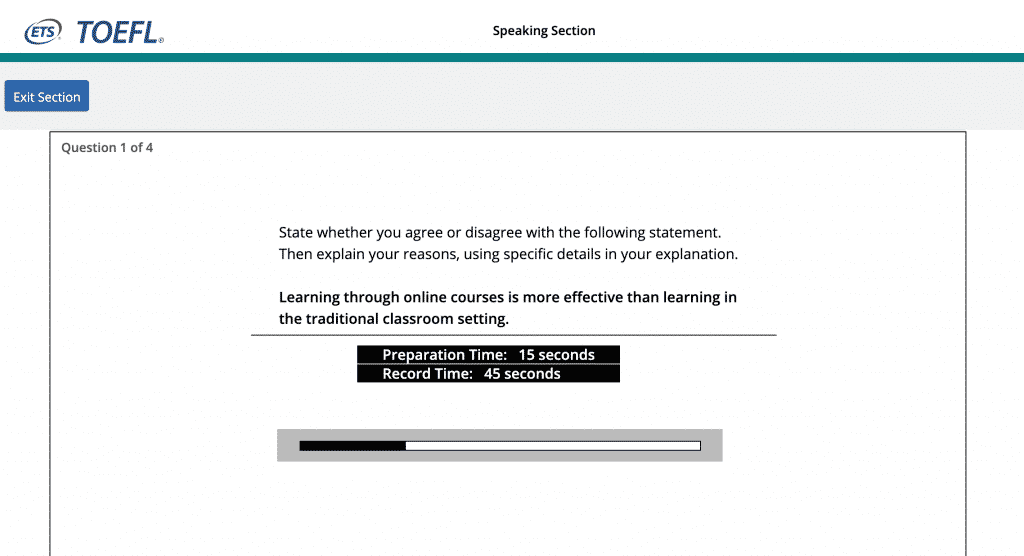Let’s take a closer look at each of the TOEFL Speaking questions, starting with question one.
TOEFL Speaking question one is 60 seconds in total.
You have 15 seconds to prepare and 45 seconds to speak. But you might be thinking, “How can I prepare and deliver a response in just 60 seconds?”
Here’s how:
- Choose a side and stick to it – Do not argue both sides
- Take notes like a pro – Write down short notes that include your reasons and examples
- Be casual – Imagine you are speaking to a friend
- Plan in advance what you are going to say – Choose an introductory phrase to use every time
- Make your life easier: follow a template – Create your own template and practice
In this article, we will take you through each step of the way so that you will feel comfortable and confident no matter what type of question you get for TOEFL Speaking question one.
Let’s take a quick look at the structure of TOEFL Speaking question one.
Here’s an image from one of ETS’ complete tests at their official website.

All you have to do is read the question and give your opinion. While all of the questions ask about your opinion, they will be in one of the following formats:
Question Type #1: Personal Preference “Some people prefer to get up early in the morning and start work. Others prefer to get up later and work until late at night. Which do you prefer?”
Question Type #2: Agree or Disagree “Do you agree or disagree with the following statement? All high school students should wear school uniforms.”
Question Type #3: Three Choices “For your last assignment, the professor expects you to create a presentation. You can work alone, with a partner, or with a group. Which would you choose?”
Question Type #4: Advantages and Disadvantages “Some teenagers work while attending high school. Please discuss the advantages and disadvantages of having a part-time job while in school.”
But how is the time divided in TOEFL Speaking question one?You have 15 seconds to prepare and 45 seconds to speak. Here’s what you must do during your preparation time:
Get access to your Templates and Strategies for TOEFL Speaking 26+ so you can learn exactly how to answer each TOEFL Speaking question.
Tip #1: Choose a side and stick to it!
While the instructions are being read, first look over the question and make sure you understand it. Then, you have to choose a side.
There are four question types in TOEFL Speaking question #1(Personal Preference, Agree or Disagree, Three Choices, Advantages and Disadvantages), and all of them ask for your opinion.
Let’s look at an example:
Would you prefer to work at one job your entire life or to switch jobs every five years?
This is a Personal Preference question and you will have to decide if you would either a) prefer to work at one job your entire life, OR b) prefer to switch jobs every five years.
Do not say, “Well it depends on the situation. A piece of me feels like it’s better to work at one job for five years, but on the other hand…”
Do not do that. Choose one side and stick to it. Your answer will be clearer, your speech will be more direct, and your response will be more organized if you choose a side and stick to it.
Check out this one-sided response:
Speaking Task 1: Sample Answer
Would you prefer to work at one job your entire life or to switch jobs every five years? Explain your response with details and examples.
To me, I definitely think that it is better to switch jobs every five years because old jobs get boring and new places are exciting. I remember when I worked at a school in New York, and at first, everything was new and interesting but by the fifth year, I was tired of taking the same train to go to the same building every day. On top of that, starting a new job is a new opportunity. For example, after my job in New York, I moved to Japan and started teaching English to children, which was completely different. It motivated me to learn and expand my knowledge. So, to sum up, if I had to choose, I would definitely opt for changing my job every five years.
Remember, no matter the question type, pick the first answer that pops in your head, and stick to one side of the argument. you need to give a one-sided opinion.
Want to see more examples? Check out over 100 more questions for the TOEFL Speaking here.
Tip #2: Take notes like a pro!
Now that you have chosen a side, you need to think of at least one reason to support your opinion AND a personal example that supports your reason. Granted, this is a lot to think about and remember in a short amount of time during a stressful exam, so what do you do?
Write it down.
Let’s look at another question:
Do you agree or disagree with this statement? “Co-workers make the best friends.”
And here are my notes:
Note Structure
O:
R1: wrk/lfe ≠
Ex1: alcol/prty
R2: frndshp ends
Ex2: Andrw mv
Opinion: disagree
Reason1: work and personal life separate
Example 1: co-worker drank too much at a party
Reason 2: friendship ends if the person leaves
Example 2: Andrew moving to another school
Look, you will develop your own style over time. It is okay if your notes do not look like mine. And remember, you only need to have one reason and one example.
The reason why I suggest keeping a few notes is because it will help you remember what you want to say when it comes time to speak.
On test day, you will be provided with a paper and pencil. Use that to write down a few notes about what you want to say while you have 15 seconds to prepare your response.
Remember, these notes are for you, to trigger your own memory. There is no right or wrong way, as long as they will help you remember what to say when the time comes!
Now you are prepared to give your response to TOEFL Speaking question one. Here’s what you should do in that 45 seconds.
Tip #3: Be casual
The TOEFL Speaking exam is testing if you feel comfortable and confident while speaking English, so you should sound as natural as possible.
Imagine you are having a casual conversation with a friend when you are answering. You are not giving a speech, and you are not reporting back to a professor. You are just talking about your feelings on a particular topic.
Listen to this example and notice the casual tone.
You have decided that you will learn a new hobby. Which of the following would you choose?
- a. Study a new language
- b. Learn how to play an instrument
- c. Join a sports team
To me, joining a sports team would definitely be the new hobby I would choose to learn. For one, playing sports is an excellent way to make new friends. It can be difficult to meet people these days, especially ones that share a common interest. But, if you enjoy the sport, your teammates will obviously enjoy it too. Another reason I would choose to join a sports team is because it keeps you fit. When I used to play volleyball, it was very physical. I never had to go to the gym, because I was able to stay healthy by playing volleyball every week. These are the reasons why, if I had to learn a new hobby, I would definitely join a sports team.
See how natural and casual he sounds? This is how you want to deliver your answers on test day.
Tip #4: Plan in advance what you are going to say
This might sound crazy because you don’t know what question you are going to get, and that is true, BUT you do know that they are going to ask for your opinion on question one. Therefore, you can and should plan in advance how you will start your answer.
Let’s take a look again at the sample answer to the question:
Would you prefer to work at one job your entire life or to switch jobs every five years?
Speaking Task 1: Sample Answer
Would you prefer to work at one job your entire life or to switch jobs every five years? Explain your response with details and examples.
To me, I definitely think that it is better to switch jobs every five years because old jobs get boring and new places are exciting. I remember when I worked at a school in New York, and at first, everything was new and interesting but by the fifth year, I was tired of taking the same train to go to the same building every day. On top of that, starting a new job is a new opportunity. For example, after my job in New York, I moved to Japan and started teaching English to children, which was completely different. It motivated me to learn and expand my knowledge. So, to sum up, if I had to choose, I would definitely opt for changing my job every five years.
It starts with the phrase:
“To me, I definitely think that…”.
This is an example of an introductory phrase that could be used to answer any of the TOEFL Speaking Questions one.
Here it is again, in the negative form, to the question:
Do you agree or disagree with this statement? “Co-workers make the best friends.”
Speaking Task 1: Sample Answer
Do you agree or disagree with the following statement?
“Co-workers make the best friends.”
Provide details and examples to explain your opinion.
To me, I definitely do not think that co-workers make good friends because it is best to keep your work and personal life separate. I remember when I worked at an English school in South Korea, I had a co-worker who had a bit too much to drink at a work party. After that, everyone in the office looked at him differently. Also, even if you are friends with your colleagues, the relationship often ends when one of you leaves the job. For example, at that same job in Korea, when my friend Andrew unexpectedly quit and moved to another school in Seoul, we hardly ever spoke since we were no longer in the same office together. That’s why I think that co-workers do not make very good friends.
- To me, I definitely think that…
- I feel that…
- Personally speaking…
- To be honest…
- I’ve never thought about this before, but…
- I have to say that…
Tip #5: Make your life easier: follow a template!
Okay, you have started speaking with your planned introductory phrase, now what? Follow a template to structure your answer!
You can use pre-planned phrases for the following reasons:
- Introducing your response
- Concluding your response
- Introducing your personal example
- Giving your opinion
Introducing your response:
- To me, I definitely think that…
- I feel that…
- Personally speaking…
- To be honest…
- I’ve never thought about this before, but…
- I have to say that…
Concluding your response:
- So, that’s why…
- As you can see…
- To make a long story short…
Introducing your personal example:
- Take … as an example…
- One example of this is…
- I remember when…
- I once heard about…
- I will never forget when…
Giving your opinion:
- In my opinion…
- I do believe that…
- I definitely think that…
- If I were asked, I would say that…
- To be honest…
Here’s my response to the question:
To me, I definitely do not think that co-workers make good friends because it is best to keep your work and personal life separate.
I remember when I worked at an English school in South Korea, I had a co-worker who had a bit too much to drink at a work party. After that, everyone in the office looked at him differently.
Also, even if you are friends with your colleagues, the relationship often ends when one of you leaves the job. For example, at that same job in Korea, when my friend Andrew unexpectedly quit and moved to another school in Seoul, we hardly ever spoke since we were no longer in the same office together.
That’s why I think that co-workers do not make very good friends.
Here’s a basic template you can follow for answering nearly any TOEFL Speaking question one.
Basic Template: Question 1 |
||
|---|---|---|
| Template | Content | Time |
| To me, I definitely think that... |
|
0-10 Seconds |
| I remember when... |
|
11-22 Seconds |
| *On top of that... |
|
23-27 Seconds |
| *For example... |
|
28-40 Seconds |
| So, to sum up... |
|
41-45 Seconds |
So, choose your own template and practice, practice, practice!
And I should have mentioned this earlier, but if you more of a video person (I certainly am!) you can watch this video guide to TOEFL Speaking question one.
Conclusion
- Choose a side and stick to it – Do not argue both sides.
- Take notes like a pro – Write down short notes that include your reasons and examples.
- Be casual – Imagine you are speaking to a friend.
- Plan in advance what you are going to say – Choose an introductory phrase to use every time.
- Make your life easier: follow a template – Create your own template and practice.
Did you find this guide helpful? Do you have any questions that don’t have an answer here? Let us know in the comments section below.
Ready to take a closer look at TOEFL Speaking Question 2?












6 Comments
Nooshin Mohebali
To me,it was definitely usefull.thanks alo🌹🌹🌹👌👌👌
Camila
In my opinion, this is the best website to learn everything about TOEFL. For example, when I search for any question about the test on Google, I know I can trust the results shown at TSTPrep. So, to sum up, let’s forget Google and just type tstprep.com and come straight ahead here.
Hikmatullah
Very useful ideas on the TOEFL speaking question 1. I have read many blogs discussing this, but this is by every means the best of its kind.
I will take the TOEFL test on June 10, 2023, and I hope to get my desired score.
Thanks😊
Josh
Thank you very much for your kind words. We at TST Prep work very hard to try and give you the best possible information. So happy you found it useful. Good luck with your test! 🙂